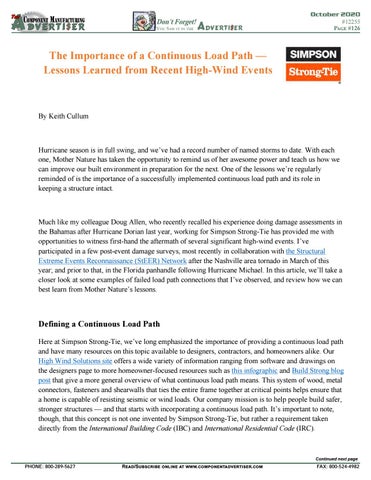A
Th e
Component Manufacturing dverti$ dverti $ er
Don’t Forget! You Saw it in the
Adverti$$er
October 2020 #12255 Page #126
The Importance of a Continuous Load Path — Lessons Learned from Recent High-Wind Events
By Keith Cullum
Hurricane season is in full swing, and we’ve had a record number of named storms to date. With each one, Mother Nature has taken the opportunity to remind us of her awesome power and teach us how we can improve our built environment in preparation for the next. One of the lessons we’re regularly reminded of is the importance of a successfully implemented continuous load path and its role in keeping a structure intact.
Much like my colleague Doug Allen, who recently recalled his experience doing damage assessments in the Bahamas after Hurricane Dorian last year, working for Simpson Strong-Tie has provided me with opportunities to witness first-hand the aftermath of several significant high-wind events. I’ve participated in a few post-event damage surveys, most recently in collaboration with the Structural Extreme Events Reconnaissance (StEER) Network after the Nashville area tornado in March of this year; and prior to that, in the Florida panhandle following Hurricane Michael. In this article, we’ll take a closer look at some examples of failed load path connections that I’ve observed, and review how we can best learn from Mother Nature’s lessons.
Defining a Continuous Load Path Here at Simpson Strong-Tie, we’ve long emphasized the importance of providing a continuous load path and have many resources on this topic available to designers, contractors, and homeowners alike. Our High Wind Solutions site offers a wide variety of information ranging from software and drawings on the designers page to more homeowner-focused resources such as this infographic and Build Strong blog post that give a more general overview of what continuous load path means. This system of wood, metal connectors, fasteners and shearwalls that ties the entire frame together at critical points helps ensure that a home is capable of resisting seismic or wind loads. Our company mission is to help people build safer, stronger structures — and that starts with incorporating a continuous load path. It’s important to note, though, that this concept is not one invented by Simpson Strong-Tie, but rather a requirement taken directly from the International Building Code (IBC) and International Residential Code (IRC).
Continued next page
PHONE: 800-289-5627
Read/Subscribe online at www.componentadvertiser.com
FAX: 800-524-4982
